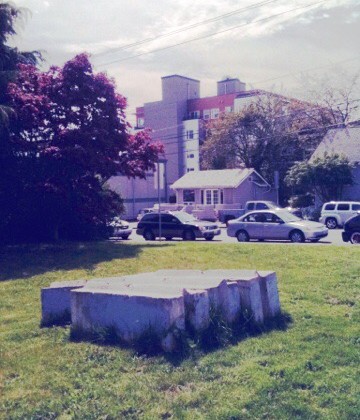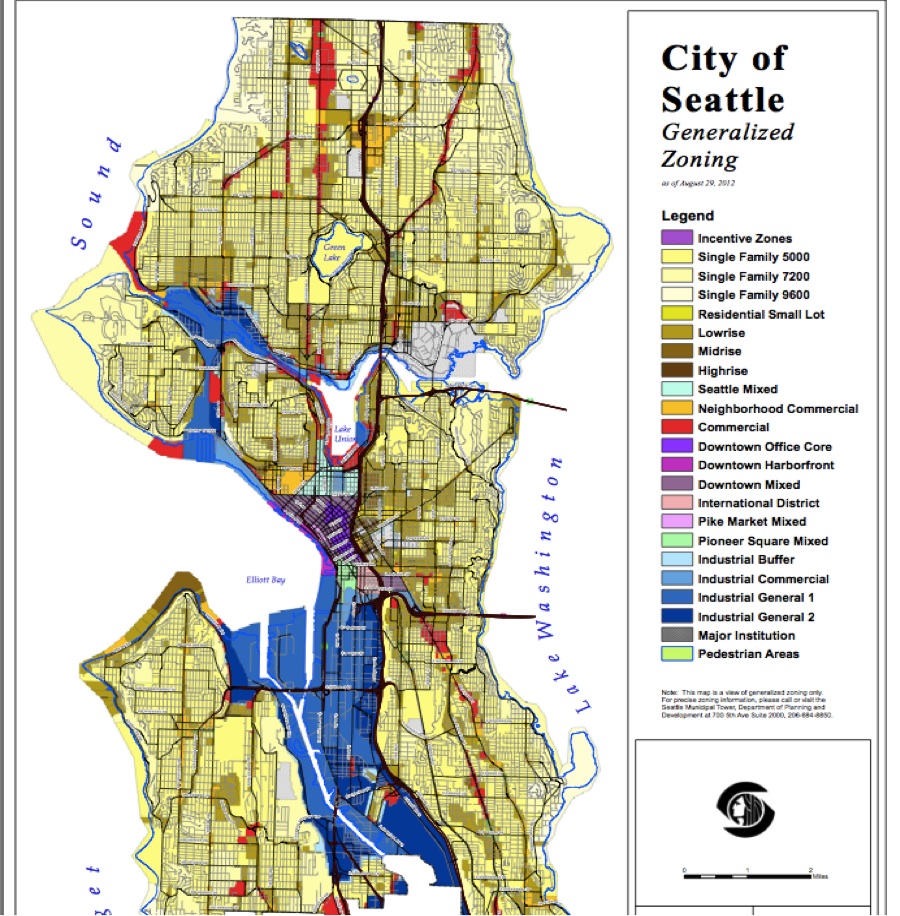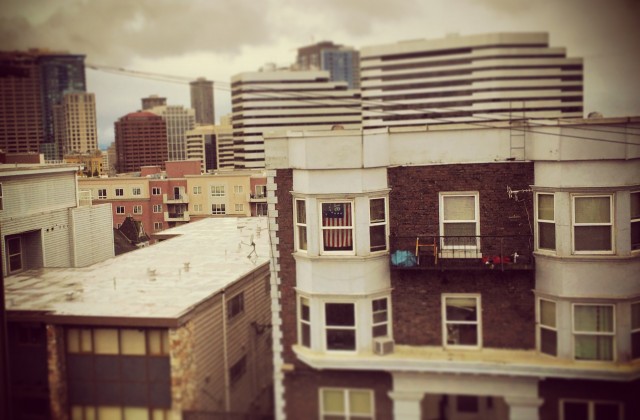Rough Ride Again: City Charges Forward With Parks Proposal
Last Thursday at the end of a long day, someone sent me a message about a story on the 11PM KING 5 News about the Roosevelt neighborhood and zoning. It turns out that the City Attorney, Mayor, and Council were having a big press conference the next morning announcing they are going to seize some property held by the errant owner (he has many judgements against him for violating the land us code) and turn it over to the Parks Department to create a park. This may seem like a great idea, but the parcels in question were at the center of an epic land use battle years ago.
Many of us were shocked and, frankly, angry that all that progress was being reversed without the least bit of process. I’m not a fan of lots of process, but it seems like we always have to go through it to get things done. But when the City decides it wants to move on something, it happens lightening fast. Here’s the letter we sent asking the City Attorney, the Mayor, and the Council to stop and explore other ideas. When we’re supposedly in a housing crisis, shouldn’t we be putting that first in line when we’re looking at seizing someone’s property?
—————
March 15, 2015
Dear City Attorney Holmes, Mayor Murray, and Councilmembers,
Many people were surprised and disappointed to learn—only at the 11th hour, literally—that the City intends to turn key property zoned for housing, in the Roosevelt neighborhood, into a park.
While you touted the proposal as an example of people at the City working outside their bureaucratic “silos,” the proposal ignores many years of discussion and about the property in question.
More than two dozen activists and leaders in the city signed a letter in the summer of 2011 asking that these parcels be used for housing, specifically for transit oriented housing. Here is an excerpt from that letter which is also attached:
The creation of transit-oriented communities supports the significant public investment in transit that will occur in Roosevelt as a result of the new station. Transit investments are most effective when combined with opportunities for more people to live, shop and work near the stations. The Planning Commission’s recent Transit Communities Report identified several communities, including Roosevelt, as areas in which more housing and infrastructure should occur to take advantage of the investment in transit. Futurewise’s Blueprint report made similar recommendations related to the Roosevelt neighborhood.
You never consulted any of the signers of this letter before making the proposal to create a park here. Furthermore, the park proposal—largely a positive one that moves on an errant property owner—never engaged the community about housing. Keep in mind, that all sides of the debate 4 years ago spent a lot of time and energy reaching a compromise on these parcels, agreeing they be zoned for housing.
You ignored that debate, discussion, and process and in a matter of a day reversed course. Remember, also, that we are currently discussing how we create policy to ensure we have affordable housing options for people of all income levels, especially near transit. While the Housing Affordability and Livability Agenda (HALA) Committee has been earnestly, and seriously looking at housing issues, you have been in a different silo planning to turn prime land zoned for transit oriented housing into a park.
Please take a step back, engage the many, many people who discussed this issue before, and let’s find a way to create housing and amenities in Roosevelt.
Sincerely,
Roger Valdez
Director
City Builder: Developer Improves Building and Affordability
The lead in segment to Seattle Channel’s recent panel discussion on proposed legislation to reduce flexibility in leases for renters is one of the best and most balanced stories about the acquisition and redevelopment of an existing building. We’ve seen the stacked stories that only cover isolated instances of a few sad stories about tenants having to leave a building that was sold and being improved. But this is the first time I’ve seen a reporter actually listen to the full story: a builder buys a building, improves it for additional, new, less expensive housing, and does right by his tenants. Watch the lead in piece and the discussion. It is refreshing change toward a more full depiction of how we can evolve and preserve existing lower rent housing in the city.
Seattle as Open City: Upzone Single-Family, End Exclusionary Zoning
Part two of a post by David Moser. David Moser works on housing for Neighborhood House, a local non-profit. This post is a draft of an in-process working paper and was selected as a finalist in Seattle University’s Policy Incubator Competition, part of it’s Master of Public Administration program.
Exclusionary Zoning in Seattle
There are obviously many possible factors that can make it difficult for a city to build enough housing supply to meet demand. Sometimes the demand is so elevated that even in the face of increased housing supply, that increased supply is still not sufficient to strike a balance, and rents keep rising. That is what is happening is Seattle now. Another reason supply can have a hard time increasing sufficiently is the raw material to produce the product is unavailable. And sometimes there isn’t enough available labor. Thankfully, none of these constraints is currently impacting us in Seattle.
It might appear that land the greatest constraint to increased supply in Seattle is available land on which to build. We are surrounded by water afterall. Cities built on flat open plains with no natural or government-imposed growth boundaries (Phoenix, Atlanta, Houston, etc) can in fact more easily increase their housing supply by expanding outward horizontally and those cities have indeed seen much less dramatic increase in housing costs than the growing coastal cities (Yglesias, 2012).
But outward is of course not the only way a city can grow. We can build in and up. Major engineering achievements like the elevator and steel-frame construction make compact housing patterns quite easy to build, from a technological standpoint. We can build apartment buildings. So scarcity of land is not the primary constraint in limiting the supply of housing.
Take a look at the Generalized Zoning Map of Seattle.
What this analysis focuses on is the residential “Single Family” zones in various shades of yellow, and the residential “Lowrise”, “Midrise” and “Highrise” zones in various shades of brown. As we can see, the majority of the city is covered by some form of “Single Family” zoning, which means only detached, suburban style single-family homes can be built in those areas. “Multi-Family” apartment buildings are only allowed to be built in the Lowrise, Midrise, or Highrise Zones colored in brown. This shows clearly what is known as the “Urban Village” strategy adopted by the city in the 1980’s under mayor Norm Rice. The goal of this strategy was to channel all new growth into the Urban Villages like Capitol Hill, Ballard, Columbia City, University District, Alaska Junction, etc.
The crucial point is that all of those “Single Family” zones (all the various shades of yellow), is off-limits to any kind of apartment building. In all these areas, increasing the supply of housing by “building in and building up” is de-facto illegal. All of the growth is being channeled and compressed into the relatively tiny pockets where low, mid, and highrise building is allowed. What this amounts to is a government-imposed cap on the supply of housing on the majority of land in the city.
The Proposal and Its Politics
The City of Seattle should convert all land currently zoned as “Single Family” to “Lowrise Residential” (changing all the areas on the zoning map currently shaded yellow to brown). This would dramatically increase the number of possible areas in which dense, compact, multi-family housing could be built throughout the city of Seattle, and would over time allow the market to increase supply at a faster rate. This policy would require no increased revenue whatsoever. And fears that this change would instantly obliterate the quiet, suburban “character” of these zones are overblown. What it would mean is that over time, gradually, here and there apartment buildings would pop up in the 50% of the city in which they are now prohibited.
This is a radical, controversial proposal, especially since residents of Single Family zones are notoriously resistant to any such “upzoning”. “Not-in-my-backyard” sentiment is a strong political force in Seattle, and any public official proposing this change would have to be prepared for fierce backlash from “neighborhood activists”. But the fact is that when low-income people are being pushed from the city due to insufficient housing supply, any artificial caps on this supply are unjustifiable from a social justice perspective. Renters and construction unions would be sure to support this policy. This proposal is a compromise with those who would like no change at all to the Single-Family Zones. It is not proposing the complete elimination of restrictions on housing supply, as pure economics and social justice would recommend. It is coming half way. Let low-rise apartment buildings be built throughout Seattle.
Housing is a good thing, like jobs and clean air. Let it be built.
Works Cited
Balk, G. (2014, May 22). Census: Seattle Fastest Growing Big City in U.S. Seattle Times , retrieved from http://blogs.seattletimes.com/fyi-guy/2014/05/22/census-seattle-is-the-fastest-growing-big-city-in-the-u-s/.
Ehrenhalt, A. (2012). The Great Inversion and the Future of the American City. New York: Random House.
Florida, R. (2010). The Great Reset: How New Ways of Living and Working Drive Post-Crash Prosperity. New York: HarperCollins.
Frumkin, H., Frank, L., & Jackson, R. (2004). Urban Sprawl and Public Health. Washington D.C.: Island Press.
Glaeser, E. (2011). Triumph of the City: How Our Greatest Invention Makes Us Richer, Smarter, Greener, Healthier, and Happier. New York, New York: Penguin Books.
Goetz, E. G. (2013). New Deal Ruins: Race, Economic Justice, and Public Housing Policy. Ithaca: Cornell University Press.
Gordon, C. (2008). Mapping Decline: St. Louis and the Fate of the American City. Philadelphia: University of Pennsylvania Press.
Gyourko, E. L. (2008). Rethinking Federal Housing Policy. Washington D.C.: American Enterprise Institute.
Jackson, K. T. (1985). Crabgrass Frontier: The Suburbanization of the United States. New York: Oxford University Press.
Mangin, J. (2014). The New Exclusionary Zoning. Stanford Law and Policy Review , 25 (91), 91-120.
Owen, D. (2009). Green Metropolis: Why Living Smaller, Living Closer, and Driving Less are the Keys to Sustainability. New York, NY: Riverhead Books.
Pietila, A. (2010). Not in My Neighborhood: How Bigotry Shaped a Great American City. Chicago: Ivan R. Dee.
Rachel G. Bratt, M. E. (2006). A Right to Housing: Foundation for a New Social Agenda. Philadelphia: Temple University Press.
Ross, B. (2014). Dead End: Suburban Sprawl and the Rebirth of American Urbanism. New York: Oxford University Press.
Sampson, R. J. (2012). Great American City: Chicago and the Enduring Neighborhood Effect. Chicago: University of Chicago Press.
Wilkerson, I. (2010). The Warmth of Other Suns: The Epic Story of America’s Great Migration. New York: Vintage Books.
Yglesias, M. (2012). The Rent is Too Damn High: What to Do About It, and Why It Matters More Than You Think. New York: Simon & Schuster.
Seattle as an Open City: Seattle’s Growth and Rising Housing Costs
The central argument of this post is that Seattle is facing a crisis of housing scarcity, and so municipal zoning restrictions on the supply of housing should be lifted.
Seattle is currently the fastest growing large city in the United States. According to U.S. Census figures, in the one-year period from July 2012 through July 2013 (the last complete twelve month period for which data are available), Seattle added over 18,000 new residents for an annual growth rate of 2.8%, outpacing Austin, Charlotte, and Washington D.C. (Balk, 2014). Spurred by a strong economic rebound from the Great Recession and a surge in hiring by Amazon and other tech companies, this growth shows no signs of slowing in the near term. And in the long term, Seattle’s diversified industrial base, its highly educated workforce, its deep-water port on the Pacific Rim, and its mild climate on a quickly warming planet suggest the likelihood of strong population growth for many decades to come. The position of this paper is that this growth should be welcomed and encouraged, but that accommodating this growth wisely and justly will require significant adjustments to the municipal land-use laws currently in place in the city of Seattle.
For this growth has, so far, seen a corresponding rapid escalation of housing prices in Seattle and across the region. Between 2010 and 2013, median apartment rents in Seattle spiked by almost 11%, the highest rate of increase in the nation during the same time period, and Seattle is now the eighth most expensive market for rental housing in the nation, with median rent for a one-bedroom apartment at $1580.00.
And of course, rising housing costs do not affect everyone the same. For low-income households struggling to make ends meet, rising rents have a disproportionate impact, since poor families on average pay a higher portion of their income for their housing than do higher income families. According to the federal department of Housing and Urban Development, a household is considered “cost burdened” if they spend more than 30% of their total household income toward housing costs, and “severely cost burdened” if they spend more 50% of their income toward housing costs. City of Seattle data shows that of the poorest households in the city (those with incomes under 30% of Area Median Income), a full 62% are severely cost burdened, paying more than half their incomes toward their housing. And there are disproportionate racial impacts as well. 35% of African American households in Seattle are “severely cost burdened”, compared with 21% of Asian households and 18% of White households (City of Seattle). This disproportionality of household rent-burden across class and race makes rising housing costs a social justice issue, not just an economic one.
Many individuals and families facing rising housing costs in Seattle have moved to less expensive cities in South King County such as Kent, Auburn, Renton and SeaTac. And many low-income people who might have considered moving to Seattle from the suburbs in order to access its more robust public transit and other services are unable to do so. This is part of a nationwide trend that the Brookings Institute has called the “suburbanization of poverty”. This phenomenon is a reversal of the dominant pattern of the 20th century in which low-income people were concentrated in the central cities, with middle and upper classes retreating to the suburbs(“white flight”). Alan Berube, in his book Confronting Suburban Poverty shows how many previously middle-class suburbs have seen their poverty rates spike in the last 15 years. And he argues that in many ways dispersed suburban poverty is worse than concentrated urban poverty, for in cities it is easier to live without a car, and the financial burden that entails.
For all of these reasons, many have begun to characterize rising housing costs as a social justice crisis. And the issue has taken an increasing sense of urgency in local politics. Last year, Socialist Councilmember Kshama Sawant was elected on a platform largely focused on rent control, and many of her campaign posters were emblazoned in large red typeface: “The Rent is Too Damn High”. Not to be outdone, in the fall of 2014 Mayor Ed Murray convened a new task-force on Housing Affordability and Livability, bringing together 30 local leaders from non-profit and for-profit housing development companies, community-based housing advocates. There is no more urgent issue in Seattle.
Survey of Affordable Housing Strategies
“Housing Policy” has historically been primarily the province of the federal government. The department of Housing and Urban Development has directly funded thousands of public housing units nationwide, as well as “Section 8” rent subsidies, but the budget for these subsidies has been slashed dramatically in recent decades (Rachel G. Bratt, 2006). These cuts at federal level have required states and municipalities to develop a wide range of policy solutions to fill the void:
Housing taxes: The City of Seattle Housing Levy and the Washington State Housing Trust Fund have together proven very effective, together funding several hundred housing units in Seattle over the last two decades.
Development fees: The Mayor’s HALA task force is considering raising revenue from housing developers through “linkage fees” and “impact fees”. However the number of projected units that could be built with this revenue is quite small, numbering in the low hundreds.
Incentive Zoning: Seattle has a policy in place called “incentive zoning” which gives developers flexibility on building restrictions in exchange for including affordable units in apartment buildings. However, in the 10 years this policy has been in place only a couple hundred affordable units have been built through this strategy.
Rent Control: Though it is currently illegal under Washington State law, many have begun to discuss the possibility of “rent control”. Due to the state prohibition against this policy, in all likelihood any rent control policy in Seattle is many years away. Additionally, many economists argue that rent control policies tend to have unintended “perverse” effects of actually raising rents for uncontrolled units. Many even put the blame for elevated rents in New York and San Francisco on the fact that they have rent control.
In a crisis, we need “all hands on deck”, and so some combination of all of these above policies is needed and warranted to address the problem. In particular, I would advocate for significant increases in the Housing Levy and the Housing Trust Fund. What I am proposing here, however, is that all of these policies are undermined and made less effective by what some call a regime of “Exclusionary Zoning” that currently dominates land-use policy in Seattle. This is because of supply and demand.
Research into the Economics of Housing
The central argument of this paper is that the primary driver of increased housing costs in Seattle is that a lot of people want to live here, and there aren’t enough available homes. Harvard economist Edward Glaeser, in his recent book Triumph of the City: How Our Greatest Invention Makes Us Richer, Smarter, Greener, Healthier, and Happier writes of New York, London, and Paris: “Robust economies and abundant pleasures have made these places highly desirable. People want to live there, and when there isn’t enough housing to satisfy demand, prices can soar” (Glaeser, 2011). As an increasingly “global” city attracting people from around the world, Seattle is subject to these same forces.
In a capitalist economy, housing is a commodity and is subject to market dynamics (Yglesias, 2012). The most prominent and well understood of these dynamics is the three-way relationship between the supply of a given commodity, the demand for that commodity, and its price. In this relationship, price acts a regulating mechanism allocating access to the commodity. If the demand for a commodity exceeds the current supply, one of two broad things can happen. The first is that producers of that good can increase the supply to meet the demand. This is called supply elasticity. However, if for some reason the producers of the desired good are not able to increase supply sufficiently (in-elastic supply), then prices will rise so that only those with either the means to pay the elevated prices will have access (Mangin, 2014).
When rents and housing prices are going up, there are two broad systemic means by which they can be lowered. The first is to reduce demand by making the city a less desirable place to live. Unfortunately we have observed too many “natural experiments” which have proven the cruel efficacy of this approach. For though not the result of intentional municipal policy, this is in fact exactly what happened in cities across the industrial Midwest that were decimated by global economic shifts in the latter half of the 20th century. In Cleveland, St Louis, Baltimore, and most dramatically Detroit, just to name a few, the pattern was repeated: the economy collapses and people stop moving in and start moving away. This causes a steep decline in demand for housing, so much so that demand for housing falls below the level of available supply, and housing prices drop dramatically. Thankfully, no sane public official would advocate this path to housing affordability (though in fact many of these cities have recently begun rebounding economically and culturally precisely because their cheap housing stock is now attracting creative people priced out elsewhere (Florida, 2010)).
The second way to stabilize prices on housing is to build enough new housing supply to meet the growing demand. This is the path advocated here. Given the deeply unjust and worsening impacts of rising housing costs discussed above, the rational and just course of action for public officials in Seattle is to move swiftly and boldly to increase the supply of housing by any means necessary.
Some will point to the fact that we are actually in the midst of a building boom in Seattle, with approximately 5,000 new housing units (mostly studios and one-bedroom apartments) having been built in the last couple years, and several thousand more in the pipeline to become available in the next couple years. Why hasn’t all this new housing supply caused prices to fall? If Seattle were experiencing a less extreme rate of population growth, with its accompanying housing demand, all these new units would in fact be meeting demand and prices would stabilize. But prices are a function of neither absolute supply nor absolute demand, but a rather a function of the relative relationship between the two. So it is very possible to have a high level of supply of something and still have prices go up if demand is extremely high. The fact is we need to build even more than we currently are if supply is to fulfill demand and stabilize prices. So, why aren’t we?
David Moser works on housing at Neighborhood House, a local non-profit. This post is a draft of an in-process working paper and was selected as a finalist in Seattle University’s Policy Incubator Competition, part of it’s Master of Public Administration program. We’re posting the paper in two parts, today and tomorrow. All notes will be at the end of the second post.
Hold the Date!
There are some dates you should get in your calendar.
First, we’ll be having our regular monthly breakfast meeting next week, on Thursday, March 12th. This meeting has been transferred to the second Thursday of the month. That’s because I have a meeting on linkage taxes that coincides with the first Thursday. The breakfast is at the Blue Star Cafe.
A week later, on March 19th, is our Spring Dinner. This is an opportunity to hear the wisdom of Mike Scott of Dupre + Scott. The event details and registration information is at the Master Builder’s website. Go there to register.







